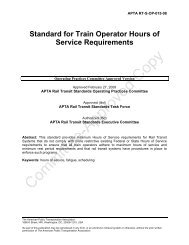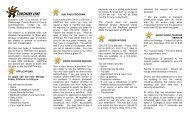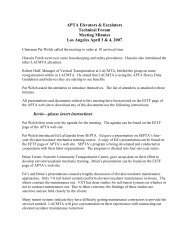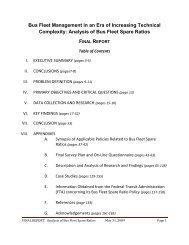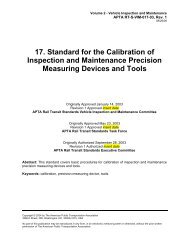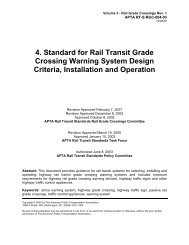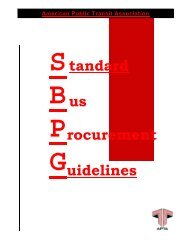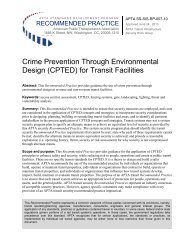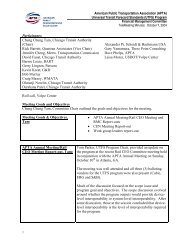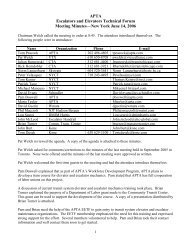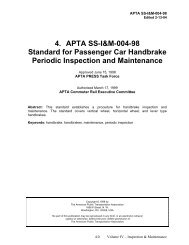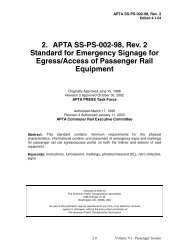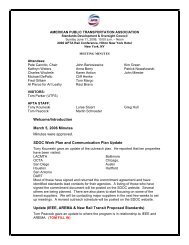4. APTA SS-PS-004-99, Rev. 1 Standard for Low-Location Exit Path ...
4. APTA SS-PS-004-99, Rev. 1 Standard for Low-Location Exit Path ...
4. APTA SS-PS-004-99, Rev. 1 Standard for Low-Location Exit Path ...
Create successful ePaper yourself
Turn your PDF publications into a flip-book with our unique Google optimized e-Paper software.
<strong>APTA</strong> <strong>SS</strong>-<strong>PS</strong>-<strong>004</strong>-<strong>99</strong>, <strong>Rev</strong>. 1<br />
Edited 4-1-04<br />
d) Begin the test by making the railcar interior completely dark. This may be done by<br />
placing the car in a dark area of the shop (car wash, etc.), working out-of-doors at<br />
night, or by masking all windows and doors with heavy paper. Close all doors. Make<br />
sure no other personnel will attempt to enter the car during the test procedure.<br />
e) Turn on normal interior lighting, make sure all fixtures are operating, and wait 20<br />
minutes to ensure that all tubes have reached stable operating temperatures.<br />
f) Start stopwatch and go through car quickly peeling back opaque tape. Leave about<br />
three inches in place to mark the location of each covered area.<br />
g) Be sure that emergency lighting circuits are disabled.<br />
h) Exactly 60 minutes after tape was peeled back, shut off all lighting.<br />
i) Exactly 90 minutes later (stopwatch reads 2 hours, 30 minutes), begin taking<br />
luminance readings using a luminance meter as described in Annex B, at each<br />
location previously covered by the opaque tape immediately adjacent to portion of the<br />
tape remaining. This procedure requires a two-person team: one to place the detector<br />
and call out readings, the other to write them down on a data sheet. Both persons<br />
must be equipped with small, red-filtered flashlights to see what they are doing. (Red<br />
light does not charge photoluminescent materials.) The measurements should be<br />
made in the same order that the tape was peeled back so they are all made 2 hours and<br />
30 minutes (+/-10 seconds), after the moment of peel back. With practice, a dozen<br />
measurements can be completed in less than three minutes.<br />
j) If the period that the LLEPM samples were covered by opaque tape was four days or<br />
longer and the HPPL materials are wider than the detector aperture of 1.38 inches (35<br />
mm), no adjustments to the data are necessary. Take a simple arithmetic average of<br />
the samples. If the average exceeds 7.5 mcd/m 2 , the car has passed. If these<br />
conditions are not satisfied, per<strong>for</strong>m the following corrections be<strong>for</strong>e taking the<br />
average.<br />
k) If the dimensions of the LLEPM samples to be measured are less than the luminance<br />
sensor aperture: 1.97 in. (50 mm) or 1.38 inches (35 mm), a special aperture plate<br />
should be ordered with a diameter slightly less than the width of the strips. The<br />
luminance meter manufacturer will supply a correction factor <strong>for</strong> this plate. Each<br />
reading must be multiplied by this correction factor.<br />
l) Alternatively, a correction factor can be determined <strong>for</strong> a standard aperture by<br />
calculating the ratio of its area to that of the area of HPPL material within the<br />
aperture. The equation <strong>for</strong> this trigonometric calculation is found in several standard<br />
handbooks, and Volpe staff will supply values on request <strong>for</strong> any given HPPL<br />
material width. For example, a HPPL sample of 1.3 inch (33 mm) width requires a<br />
correction factor of 1.016 <strong>for</strong> a 35 mm aperture. These correction factors assume that<br />
the detector is precisely centered on the material when the measurements are taken.<br />
Hence, it is better to order a special aperture plate so that it is easy to center the<br />
detector on the material.<br />
<strong>4.</strong>21<br />
Volume VI - Passenger System



